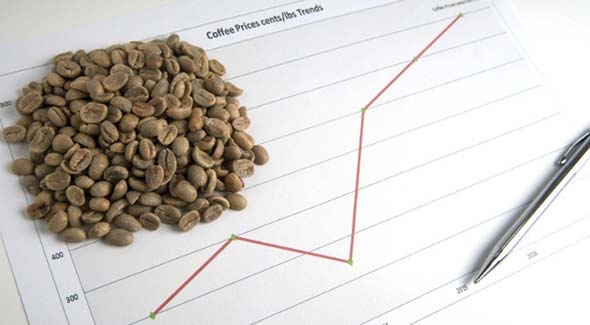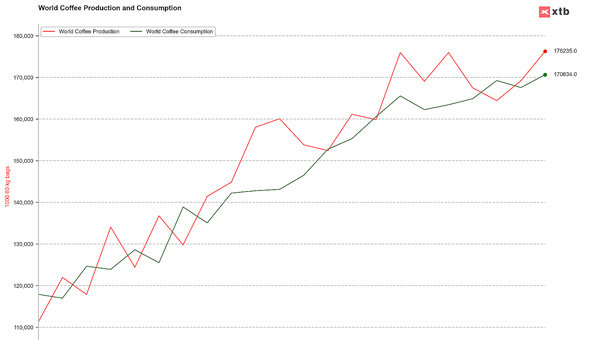The price of coffee will rise further: what can be done to counteract this increase?
You will have noticed for some time now, both at the bar and at the supermarket, that the cost of a cup of espresso is soaring. Yes, but why is the price of coffee increasing? Given that in recent months, the increase in the price of coffee has put producers, roasters and consumers in difficulty, the causes are multiple and complex.
Our previous article “Climate change: the impact on coffee” has already addressed one of the main problems: climate change, which is distorting production.
In Brief: It is not just the climate that influences the market. Shipping delays, currency fluctuations and increasingly stringent environmental regulations are making the sector unstable. In particular, the difficulties in the Red Sea and the new EU rules on deforestation are adding further pressure.
Speculation and transport crisis: an explosive mix
In addition to natural events, the coffee market is influenced by financial speculation. The strengthening of the dollar against the euro and the growing demand for robusta have made sourcing difficult, with roasters competing to grab the best qualities available.
Added to this are logistical problems. The previous crisis of the Suez Canal (not fully resolved) and the rerouted routes in the Red Sea have increased shipping costs and times, pushing up prices throughout the supply chain.

The possible solutions in place to mitigate the increase in coffee
Once we have reviewed the causes that have led to this surge in prices over time, let’s now look at the possible countermeasures. In a context of complete uncertainty such as the current one, a strategic approach could be adopted, based on several factors:
Diversifying supply sources
To reduce dependence on a few large producers, importers and roasters should explore new emerging markets that are less affected by climate and geopolitical crises. By expanding the network of suppliers, risks related to price fluctuations could be mitigated. This would reduce dependence on a single producer or geographical area. For example, the European Union has adopted strategies to diversify the sources of supply of critical raw materials, joining the Minerals Security Partnership to reduce dependence on traditional suppliers. Similarly, in the coffee sector, diversifying sources can increase the resilience of the supply chain.
Investing in sustainability and resilient agriculture
Supporting more resilient agricultural practices can stabilize production in the long term. The adoption of agroforestry techniques and the selection of varieties that are more resistant to climate change are fundamental steps. For example, in Brazil, farmers like Marcelo Montanari have implemented regenerative agriculture practices, reducing the use of chemicals and integrating organic alternatives to improve resilience against adverse weather conditions. In Italy, however, a virtuous example of eco-sustainable commitment is certainly Lavazza which has already implemented policies aimed at minimizing environmental impact for some time now.
Furthermore, more careful management of water resources could mitigate the effects of drought, considering that agriculture is responsible for approximately 70% of water withdrawals globally.

Innovation and technology at the service of the sector
Artificial intelligence and satellite monitoring can help farmers predict weather conditions and optimize crops. For example, the use of sensors and climate data enables precision agriculture, optimizing the use of resources such as water and fertilizers. In addition, new roasting techniques could reduce dependence on specific varieties, making production more flexible. Adopting advanced technologies can help mitigate the risks associated with climate change and market fluctuations.
International cooperation and more flexible regulation
The sector must promote dialogue between governments, international organizations and producers to ensure sustainable environmental regulations without hindering trade. Greater collaboration could facilitate shared solutions to the crisis. For example, Italian-Tunisian cooperation has led to the creation of a €25 million fund (called Adapt program) to support sustainable agriculture and fisheries projects in Tunisia, facilitating access to financing for private operators in the agricultural and fisheries sectors. This type of partnership can help develop more sustainable and resilient agricultural practices, benefiting all parties involved.
Educate and raise awareness among consumers
Informing the public about the complexity of the coffee supply chain is essential to raise awareness and justify any price increases. Transparency throughout the production chain, from farm to cup, allows consumers to better understand the challenges faced by producers and the importance of sustainable practices. For example, initiatives such as the application of blockchain technology in the coffee supply chain guarantee the traceability and authenticity of the product, offering detailed information on each stage of the production process.
Choosing transparent and sustainable suppliers not only supports ethical practices, but also promotes a culture of responsible consumption. Organizations such as Slow Food encourage consumers to become active participants in the supply chain, transforming them from simple buyers to conscious participants, supporting artisanal and environmentally friendly production methods.

Building strategic reserves
Building strategic coffee reserves can mitigate the effects of sudden price swings, providing greater stability and continuity in distribution, although this is a strategy that should have been started in good time. This approach is similar to that adopted in other sectors, such as energy, where strategic reserves help manage market fluctuations and protect against disruptions in the supply chain. In the context of coffee, maintaining adequate inventories can act as a buffer against price changes due to unexpected weather or geopolitical events.
Financial strategies to stabilize the market
The use of financial instruments such as hedging (a practice of carrying out one or more hedge transactions to protect against the risks associated with another investment) allows companies to protect themselves from fluctuations in prices and exchange rates. For example, companies can enter into futures or options contracts to fix the purchase prices of coffee, reducing the uncertainty associated with market changes. However, some large companies, such as Starbucks, have recently reduced the use of financial hedges, increasing their exposure to coffee price volatility.
Long-term agreements between producers and buyers can also provide greater stability. These contracts establish price and supply conditions for extended periods, providing security to both farmers and roasters. Such agreements can incentivize investments in sustainable agricultural practices, improving the quality and resilience of production.
Conclusion: Hope for a more stable and sustainable future
To address current challenges, the coffee industry must adopt a strategic and diversified approach. Investing in technological innovation, such as the use of advanced traceability systems, can improve transparency and efficiency in the supply chain. Promoting sustainability through responsible agricultural practices and supporting farming communities is essential to ensuring the quality and availability of coffee in the long term. Finally, international cooperation and the adoption of flexible regulations can facilitate shared solutions, helping to stabilize prices and create a stronger future for all actors involved in the supply chain.
In the hope of seeing these solutions put into practice, stay tuned, to the next article.




Visita il nostro e-shop e scopri tanti prodotti a prezzi vantaggiosi!